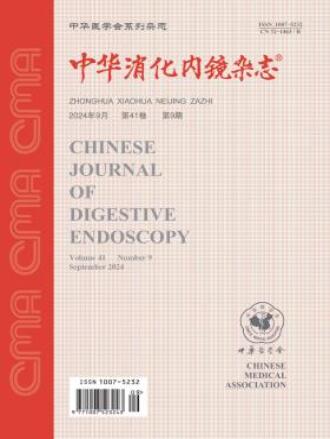儿童胰胆管疾病内镜逆行胰胆管造影的并发症
引用次数: 0
摘要
目的探讨儿童胰胆管疾病内镜逆行胰胆管造影(ERCP)并发症的发生率、影响因素及相应的治疗方法。方法回顾性分析2008年1月至2017年12月在杭州市第一人民医院接受ERCP检查的172例16岁以下胰胆管疾病患儿的临床资料。分析麻醉类型、诊断、治疗方法及术后并发症。结果172例患者共行375次ERCP,其中胆管疾病210例(56.0%),胰腺疾病245例(65.3%)。进行胰管和胆管的解剖、结石的去除、内假体的插入以及胰管或胆管的引流。ERCP的成功率为99.5%(373/375)。并发症发生率为6.7%(25/375),其中ERCP术后胰腺炎13例(3.5%),出血8例(2.1%),术后胆管炎6例(1.6%)。所有并发症均治愈。未发生重症胰腺炎、穿孔或ERCP相关死亡。首次ERCP手术和重复插管是ERCP术后胰腺炎的危险因素(P<0.05)。儿童内镜乳头括约肌切开术后ERCP出血的风险更高(P<0.05)。应该给予这些儿童更多的关注和及时的治疗。由经验丰富的内窥镜医生采用适当的治疗方法,可以有效、安全地对儿童进行ERCP手术。关键词:胰胆管造影,内镜逆行;胰腺疾病;胆管疾病;儿童;术后并发症本文章由计算机程序翻译,如有差异,请以英文原文为准。
Complications of endoscopic retrograde cholangiopancreatography in children with pancreaticobiliary diseases
Objective
To study the incidence, influencing factors and corresponding treatment of complications of endoscopic retrograde cholangiopancreatography (ERCP) in children with pancreaticobiliary diseases.
Method
Clinical data of 172 children aged under 16 years with pancreaticobiliary diseases receiving ERCP between January 2008 and December 2017 in Hangzhou First People′s Hospital were studied retrospectively. Anesthesia type, diagnosis, therapeutic methods and postoperative complications were analyzed.
Results
A total of 375 ERCP procedures were performed on 172 patients, among whom there were 210 cases (56.0%) of bile duct diseases and 245 (65.3%) pancreatic diseases. Dissection of pancreatic duct and biliary duct, calculus removal, insertion of endoprosthesis and drainage of pancreatic duct or biliary duct were performed. The success rate of ERCP was 99.5% (373/375). The incidence of complications was 6.7% (25/375) including 13 cases (3.5%) of post-ERCP pancreatitis, 8 cases (2.1%) of bleeding, and 6 cases (1.6%) of postoperative cholangitis. All the complications were cured. No severe pancreatitis, perforation or ERCP-related death occured. The first ERCP procedure and repeated cannulations were the risk factors of post-ERCP pancreatitis (P<0.05). Children had higher risk of post-ERCP bleeding after endoscopic sphincterotomy (P<0.05).
Conclusion
The incidence of post-ERCP complications in children is similar to that of adults and is related to therapeutic methods. More attention and timely treatment should be given to those children. ERCP can be effectively and safely for children operated by an experienced endoscopic physician with appropriate therapeutic methods.
Key words:
Cholangiopancreatography, endoscopic retrograde; Pancreatic diseases; Bile duct diseases; Child; Postoperative complications
求助全文
通过发布文献求助,成功后即可免费获取论文全文。
去求助
来源期刊
CiteScore
0.10
自引率
0.00%
发文量
7555
期刊介绍:
Chinese Journal of Digestive Endoscopy is a high-level medical academic journal specializing in digestive endoscopy, which was renamed Chinese Journal of Digestive Endoscopy in August 1996 from Endoscopy.
Chinese Journal of Digestive Endoscopy mainly reports the leading scientific research results of esophagoscopy, gastroscopy, duodenoscopy, choledochoscopy, laparoscopy, colorectoscopy, small enteroscopy, sigmoidoscopy, etc. and the progress of their equipments and technologies at home and abroad, as well as the clinical diagnosis and treatment experience.
The main columns are: treatises, abstracts of treatises, clinical reports, technical exchanges, special case reports and endoscopic complications.
The target readers are digestive system diseases and digestive endoscopy workers who are engaged in medical treatment, teaching and scientific research.
Chinese Journal of Digestive Endoscopy has been indexed by ISTIC, PKU, CSAD, WPRIM.

 求助内容:
求助内容: 应助结果提醒方式:
应助结果提醒方式:


